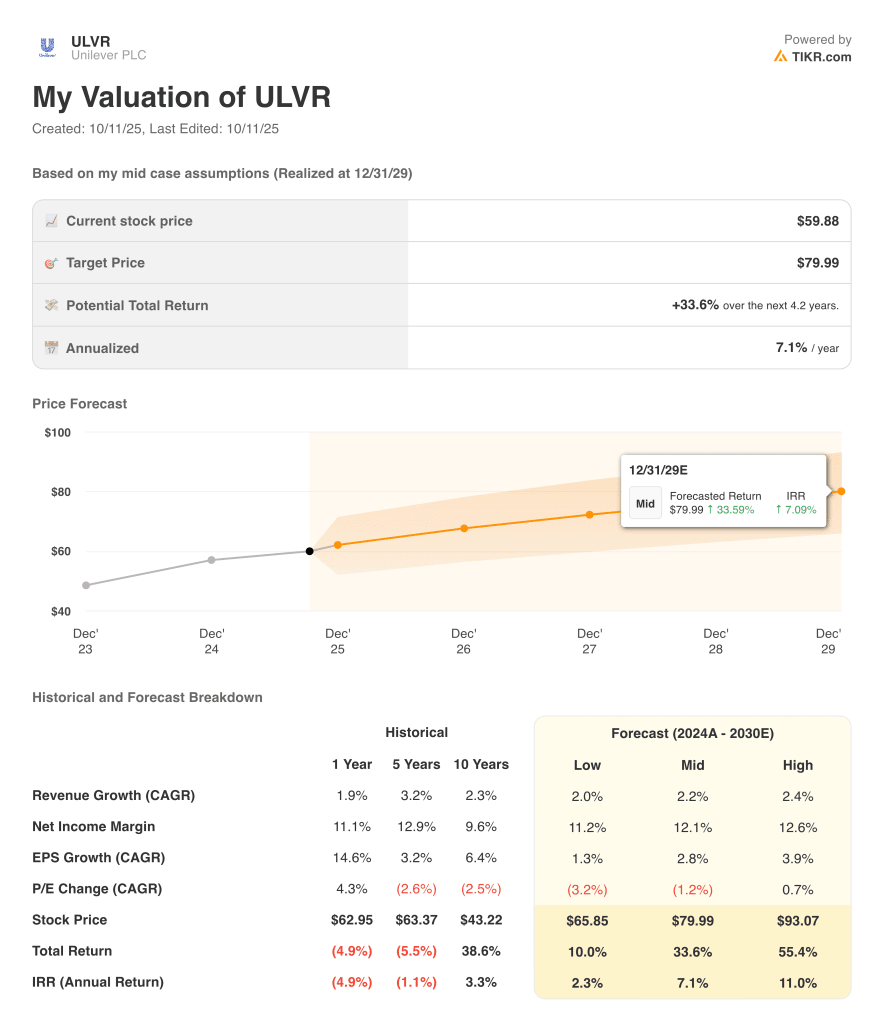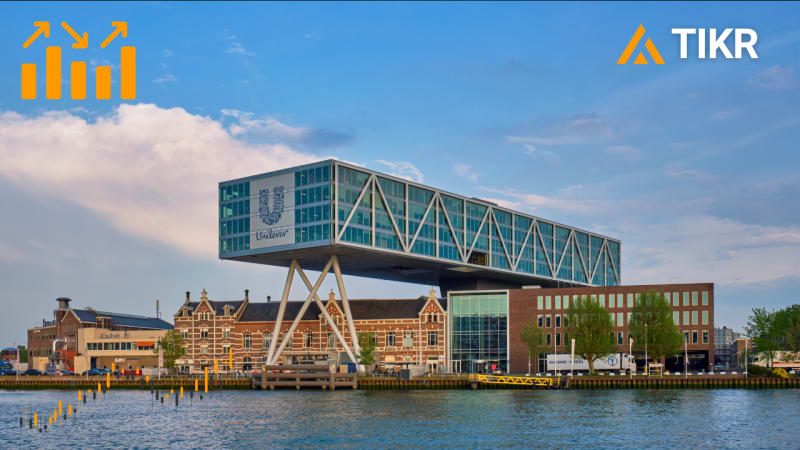Unilever PLC (ULVR) entered 2025 determined to prove that its “Growth Action Plan” could turn incremental progress into sustainable momentum. For the first half of the year, underlying sales grew 3.4%, with volume up 1.5% and price up 1.9%, led by resilience in Beauty & Wellbeing and steady recovery in Personal Care.
Yet headline turnover fell 3.2% to €30.1 billion, weighed down by currency effects and divestments, while net profit declined 5% to €3.8 billion. The company’s underlying operating profit slipped 4.8% to €5.8 billion, reflecting higher input and marketing costs, though its gross margin expanded to 45.7% as brand investments began to pay off.
The first half results illustrated both progress and fragility. Productivity savings helped offset cost inflation, but Unilever’s underlying operating margin narrowed by 30 basis points to 19.3%, underscoring the company’s delicate balance between growth and profitability. Management reiterated full-year guidance of 3–5% underlying sales growth and at least 18.5% operating margins in the second half, signaling confidence in stronger execution ahead. However, investors appear cautious: the stock is down roughly 2% year-to-date as of early October, underperforming broader European staples peers.

Still, there are signs of genuine strategic improvement. The company’s €650 million cost-saving programme remains ahead of schedule, and Unilever is set to complete the demerger of its Ice Cream division by mid-November 2025, a move designed to simplify operations and focus capital on higher-growth categories like Beauty, Wellbeing, and Home Care. CEO Fernando Fernandez said the company’s priorities are “clearer than ever,” pointing to sharper focus on premium brands, faster innovation, and more disciplined portfolio management in the months ahead.
Financial Story: A Reset Year With Glimmers of Recovery
Unilever’s 2025 financial story is best described as transitional. The company continues to make operational progress, cutting complexity, investing in innovation, and protecting pricing power, but market growth remains soft. Underlying sales growth of 3.4% reflected modest volume gains and stable pricing, though performance varied widely by region and category.
Developed markets like North America and Europe delivered mid-single-digit growth, supported by stronger execution and brand investment. In contrast, emerging markets such as India and Indonesia experienced temporary softness due to tax reforms and distributor adjustments.
| Metric | H1 2025 | H1 2024 | YoY Change | Commentary |
|---|---|---|---|---|
| Turnover | €30.1B | €31.1B | ▼ 3.2% | Impacted by FX and divestments, but stable underlying sales |
| Underlying Sales Growth (USG) | 3.4% | 4.2% | ▼ 0.8 pts | Lower volumes, modest pricing |
| Underlying Operating Profit | €5.8B | €6.1B | ▼ 4.8% | Margin pressure from higher investment |
| Underlying Operating Margin | 19.3% | 19.6% | ▼ 30 bps | Brand reinvestment offsetting cost gains |
| Net Profit | €3.8B | €4.0B | ▼ 5.1% | Ice Cream separation costs and currency headwinds |
| Diluted EPS | €1.42 | €1.47 | ▼ 3.7% | Lower margins and FX drag |
| Free Cash Flow | €1.1B | €2.2B | ▼ 50% | Working capital build ahead of Ice Cream separation |
| Dividend (Quarterly) | €0.4528 | €0.44 | ▲ 3% | Commitment to steady capital returns |
| Buyback | €1.5B | — | New | Completed under 2025 programme |
Margins remain under pressure, but the trend is improving. Unilever’s gross margin rose 40 basis points to 45.7%, driven by mix improvements and lower input costs. Still, operating margins declined due to heavier marketing and restructuring spend. Management is betting that this reinvestment will pay off in 2026, especially as Ice Cream, long a lower-margin business, prepares for its spin-off. The company reaffirmed its target for underlying operating margins above 18.5% in the second half, which would mark a significant step up from H1 levels.
Cash generation was softer in the first half at €1.1 billion, largely due to separation-related costs and working capital timing, but the balance sheet remains stable with leverage near 2x EBITDA. The company completed a €1.5 billion share buyback and maintained its progressive dividend policy, signaling confidence in the long-term plan despite near-term volatility. For now, investors appear willing to wait, but they’ll want to see that Unilever’s restructuring efforts translate into tangible growth acceleration and consistent earnings delivery by 2026.
See Unilever’s full financial results & estimates (It’s free) >>>
1. Beauty & Wellbeing and Personal Care Take the Lead
Unilever’s Beauty & Wellbeing and Personal Care divisions continue to carry the portfolio. Combined, these segments account for more than 40% of group sales, and both delivered mid-single-digit growth in the first half. Beauty & Wellbeing grew 3.7%, with strength in Dove, Vaseline, and the company’s Wellbeing brands offsetting weaker performance in China and Indonesia. Personal Care rose 4.8%, led by deodorants and skin cleansing, while continued premium product success helped defend pricing and mix.
The company’s recent acquisitions, including Dr. Squatch, Wild, and Minimalist, reinforce this premiumization strategy. These smaller, higher-margin brands are expected to fuel category growth over time and help Unilever compete more effectively in developed markets. Management highlighted that Wellbeing has now achieved 21 consecutive quarters of double-digit growth, underscoring its role as a structural growth engine within the broader portfolio.
That said, the beauty and personal care markets remain intensely competitive, particularly in Asia, where local players continue to pressure pricing. Unilever is focusing on margin discipline and digital commerce expansion to balance growth with profitability, signaling that volume recovery in these categories may take time to fully materialize.
2. Ice Cream Demerger and Portfolio Simplification
The separation of Unilever’s Ice Cream business marks one of the company’s most significant strategic shifts in a decade. As of July 1, 2025, the division began operating independently, with the full demerger set for mid-November. Post-spin, Unilever will retain a minority stake of less than 20% in the new Magnum Ice Cream Company, which will include brands like Ben & Jerry’s and Cornetto. Management expects the move to sharpen focus, streamline operations, and enhance capital efficiency.
Ice Cream delivered 5.9% underlying sales growth in the first half, with both in-home and out-of-home categories performing well. However, the business continues to face seasonal volatility and a higher cost structure, one of the key reasons Unilever decided to separate it. The demerger is expected to unlock value by allowing both entities to pursue distinct growth strategies tailored to their markets.
For Unilever’s remaining segments, the divestment will simplify reporting and improve margin visibility. By removing a lower-margin category, the company expects improved group profitability and a stronger focus on its higher-growth Power Brands, which now account for more than 75% of turnover.
Value stocks in less than 60 seconds with TIKR’s new Valuation Model (It’s free) >>>
3. Rebuilding Momentum in Emerging Markets
Emerging markets, which account for over half of Unilever’s revenue, remain a mixed picture. India, typically a bright spot, faced temporary disruptions from recent Goods and Services Tax reforms, which reduced tax rates on 40% of Unilever’s portfolio but led to short-term inventory adjustments. Indonesia is expected to return to growth in the second half, while China is showing early signs of stabilization as Unilever resets its go-to-market strategy toward premium and digital segments.
Latin America remains the weak link. Economic volatility in Brazil and Mexico weighed on sales in the first half, and management has warned that the region’s contribution will likely remain muted for the rest of 2025. Still, Unilever’s broad geographic balance provides resilience, with strong showings in North America and Europe helping offset softness in emerging markets.
Looking ahead, the company’s strategy in emerging markets remains focused on affordability, innovation, and digital distribution. Management expects the combination of lower inflation, easing commodity costs, and improved consumer confidence to support a gradual recovery across developing economies in 2026.
The TIKR Takeaway

Unilever’s turnaround is showing signs of stabilization, but the road to consistent growth remains uneven. The company is executing well on cost savings and portfolio simplification, yet its revenue momentum continues to lag that of global peers such as Nestlé and Procter & Gamble. The upcoming Ice Cream spin-off is a key milestone, one that should help refocus resources on higher-margin businesses, but execution will be everything.
For now, Unilever is caught between transformation and delivery. Its brands are strong, its balance sheet is healthy, and its strategy is clear, but investors will need patience as the company rebuilds operating leverage and scales its premium growth engines. FY2026 looks like another rebuilding year, but if management delivers on its margin guidance and achieves smoother top-line acceleration, the long-term story could regain its appeal.
Should You Buy, Sell, or Hold Unilever?
Based on the current trajectory, Unilever is arguably deserving of a spot in a portfolio. The company is operationally stable but still digesting its restructuring phase, and near-term growth prospects remain modest. With valuations reasonable and dividend growth steady, downside risk appears limited, but there’s little immediate catalyst for upside until the Ice Cream spin-off is complete and margin improvements show through.
Long-term investors may find Unilever appealing for its defensive characteristics and strong cash generation, but the next 12 months will be about execution. If management can sustain margin recovery and deliver consistent mid-single-digit growth, sentiment could begin to thaw, turning a cautious hold into a quiet comeback.
Quickly value any stock with TIKR’s powerful new Valuation Model (It’s free!) >>>
AI Compounders With Massive Upside That Wall Street Is Overlooking
Everyone wants to cash in on AI. But while the crowd chases the obvious names benefiting from AI like NVIDIA, AMD, or Taiwan Semiconductor, the real opportunity may lie in the AI application layer, where a handful of compounders are quietly embedding AI into products people already use every day.
TIKR just released a new free report on 5 undervalued compounders that analysts believe could deliver years of outperformance as AI adoption accelerates.
Inside the report, you’ll find:
- Businesses already turning AI into revenue and earnings growth
- Stocks trading below fair value despite strong analyst forecasts
- Unique picks most investors haven’t even considered
If you want to catch the next wave of AI winners, this report is a must-read.
Click here to sign up for TIKR and get your free copy of TIKR’s 5 AI Compounders report today.
Looking for New Opportunities?
- See what stocks billionaire investors are buying so you can follow the smart money.
- Analyze stocks in as little as 5 minutes with TIKR’s all-in-one, easy-to-use platform.
- The more rocks you overturn… the more opportunities you’ll uncover. Search 100K+ global stocks, global top investor holdings, and more with TIKR.
Disclaimer:
Please note that the articles on TIKR are not intended to serve as investment or financial advice from TIKR or our content team, nor are they recommendations to buy or sell any stocks. We create our content based on TIKR Terminal’s investment data and analysts’ estimates. Our analysis might not include recent company news or important updates. TIKR has no position in any stocks mentioned. Thank you for reading, and happy investing!

